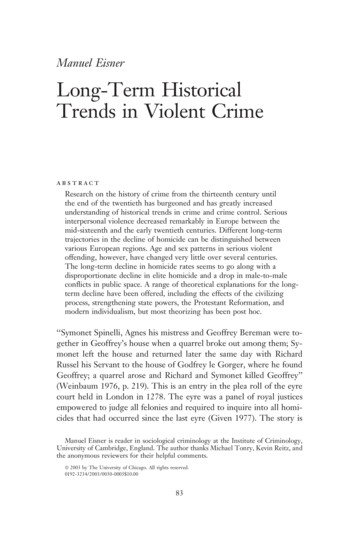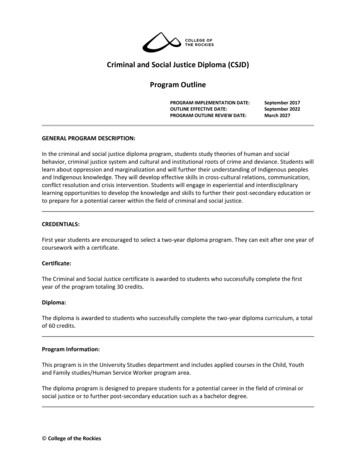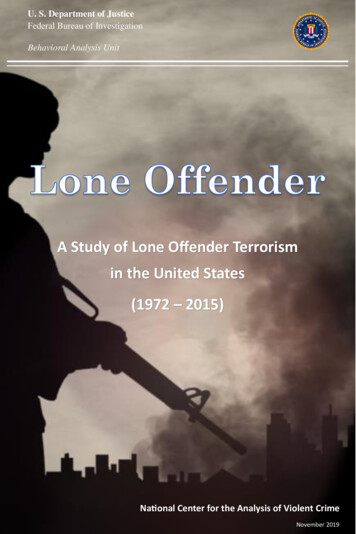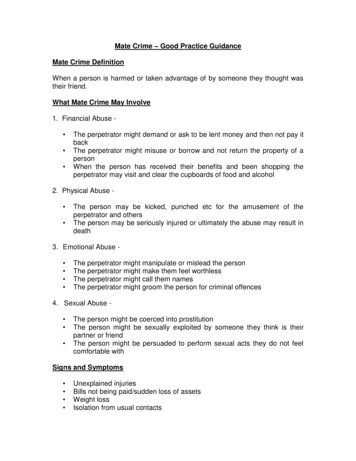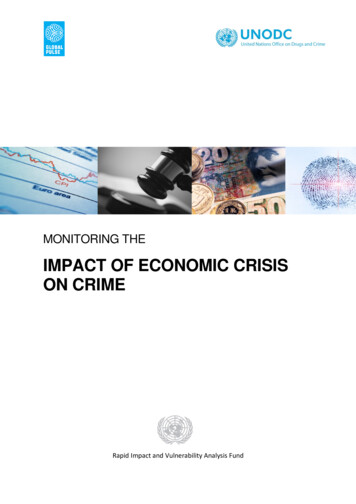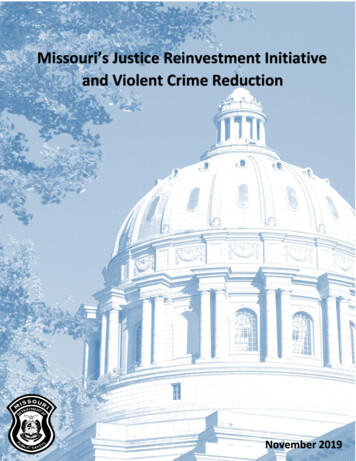
Transcription
Missouri’s Justice Reinvestment Initiativeand Violent Crime ReductionNovember 2019
Missouri’s Justice Reinvestment Initiative and Violent Crime ReductionBackground. In May 2017, Missouri state leaders requested technical assistance from The Council ofState Governments Justice Center (CSG Justice Center) with support from The Pew Charitable Trusts(Pew) and the U.S. Department of Justice’s Bureau of Justice Assistance (BJA) to use a data-driven JusticeReinvestment approach.On June 28, 2017, Executive Order 17-17 was issued, and established the bipartisan Missouri StateJustice Reinvestment Task Force to study the state’s criminal justice system. This task force realized theneed for Missouri to collaborate across agencies, apply best practice research in corrections from otherstates, and identify other opportunities to implement evidence-based practices in the state’s correctionsand criminal justice system. The 21-member task force, which included representation from theGovernor’s office, state executive branch departments, state lawmakers, members of the judiciary,corrections officials, prosecuting and defense attorneys, law enforcement representatives, formeroffenders, and behavioral health practitioners met five times between July and December 2017 toreview analyses and to discuss policy options. Through this comprehensive data analysis, the MissouriState Justice Reinvestment Task Force identified the following primary challenges contributing tocriminal justice trends in Missouri: Increases in violent crime. Missouri’s violent crime rate increased 13% between 2010 and 2016,with the steepest increase (20%) occurring between the years of 2013 and 2016. During this sametime period, arrests by law enforcement for reported incidents of violent crime decreaseddramatically. Further, many law enforcement agencies were found to lack the capacity to collect,analyze, and use data to inform deterrence, prevention, or interdiction strategies to addressviolent crime, underscoring the need for reform. Insufficient behavioral health treatment. The majority of people admitted to prison in Missouri orstarting terms of community supervision in FY 2016 were assessed as needing treatment forsubstance addictions or mental illnesses. Additionally, a lack of available community-basedbehavioral health treatment created two interrelated problems for individuals involved with thecriminal justice system who also have behavioral health needs: (1) individuals supervised in thecommunity had few, if any, quality treatment options that were easily or moderately accessible,and (2) because of this lack of access to treatment in the community, more individuals weresentenced to institutional treatment at state prisons who could have been safely supervised in thecommunity. These related problems had persistently high human and fiscal costs for Missouri forthe decade spanning 2006 to 2016. Rising prison admissions. Missouri’s incarceration rates have increased substantially since 2010. Atthe beginning of the Justice Reinvestment process Missouri’s incarceration rate was the eighthhighest in the nation and had increased four percent since 2010 while the national incarcerationrate declined eight percent. High recidivism. More than half of people admitted to Missouri state prisons in FY 2016 wereadmitted due to revocations from probation or parole supervision. Of these revocation returns,more than half were admitted due to a technical violation of the conditions of supervision.Changes are needed to better assess, treat, and supervise people on probation and on parole whilestill holding them accountable.1
Upon conclusion of the Justice Reinvestment Phase I data review process, the Missouri State JusticeReinvestment Task Force voted unanimously to endorse a number of policy initiatives aimed ataddressing identified challenges. The final framework for the changes to Missouri’s criminal justicesystem was translated into House Bill (HB) 1355 (2018) which was signed into law on June 1, 2018. HB1355 enacted changes to supervision practices, risk and needs assessment, community behavioralhealth treatment and services, and crime victim compensation, as well as creating a state fund to assistlaw enforcement to address violent crime.Like much of the country, Missouri’s criminal justice system is highly decentralized making local lawenforcement and its community partners vital to the successful implementation of criminal justice policyinitiatives. Recognizing this dynamic, HB 1355 created the Missouri Law Enforcement AssistanceProgram (MOLEAP), an initiative intended to meet the needs of local law enforcement and enable themto address violent crime in their region through evidence-based practices. When law enforcement useevidence-based practices to address the unique nature of violent crime in their jurisdictions, thecascading social and financial costs can be alleviated. Diverting individuals to a community-basedintervention will help to improve public safety and reduce unnecessary justice system involvement.After MOLEAP was passed into law, state leaders at the Missouri Department of Public Safety (DPS), aswell as their counterparts on the Justice Reinvestment Initiative Executive Oversight Committee, soughtinput from law enforcement across the state to identify the challenges and barriers to addressing violentcrime and to discover viable strategies Missouri law enforcement are utilizing. Input from lawenforcement was obtained in three ways: (1) a State Public Safety Forum held in December 2018, (2) astatewide survey of law enforcement leadership disseminated in June 2019, and (3) a series of sevenregional focus groups with law enforcement leadership held in July and August 2019. This engagementwith Missouri law enforcement was designed to gather information to support law enforcement to buildanalytical capacity, upgrade data collection systems, and enhance community policing efforts.Survey and Focus Group Methodology. In June 2019, DPS worked with the CSG Justice Center andrepresentatives from the Missouri Police Chiefs’ Association and the Missouri Sheriffs’ Association todesign an outreach strategy to reach as many law enforcement leaders as possible through an electronicsurvey and a series of seven regional focus groups.The survey asked law enforcement leaders across the state about the challenges, barriers, and resourcesthat either hinder or help efforts to implement evidence-based practices to reduce violent crime. Theeighteen-question Missouri Law Enforcement Survey was sent electronically to 652 law enforcementagencies statewide, including police chiefs, sheriffs, state police command staff, college/university police,airport, railroad, and transit police. The survey asked law enforcement leaders at those agencies toidentify barriers to the implementation of evidence-based, data-driven violent crime reduction effortsand how the state can help address those barriers and challenges and support law enforcement in theirefforts to address violent crime. An interactive dashboard of the survey’s results can be found at this link.To offer law enforcement another venue to provide insight into barriers and challenges to addressingviolent crime, DPS partnered with a nationally renowned law enforcement expert to conduct sevenregional focus groups across the state. Law enforcement leaders were invited by DPS with the assistancefrom the Missouri Police Chiefs’ Association and Missouri Sheriffs’ Association to attend the focus grouplocation closest to their jurisdiction or main office location. Focus groups were held in the followinglocations: Poplar Bluff (southeast), St. Louis (east), Kirksville (northeast), Jefferson City (central),Springfield (southwest), Kansas City (west), and St. Joseph (northwest). Sheriffs, police chiefs, state and2
federal law enforcement, and supervisors from across the state participated in the focus groups andprovided regional context to the results of the law enforcement survey. DPS staff attended the focusgroups to take notes and catalog responses to the questions posed.The law enforcement survey and focus groups posed questions designed to examine three themespresent in the feedback from law enforcement at the State Forum on Public Safety in December 2018:(1) Challenges facing law enforcement to reducing violent crime;(2) Resources needed to reduce the impact of identified challenges; and(3) Promising existing programs or practices that have a positive impact on reducing violent crime.This report combines findings from both the survey and the focus groups to examine each of these threethemes.Figure 1: Survey Respondent Demographics (n 350)Survey Participants. The law enforcement survey was sent electronically to 652 law enforcementleaders statewide. Overall, 350 individuals participated in the survey for a 54% response rate. Over twothirds of participants represented police department leadership (67.4%) and the overwhelming majority(81.4%) of all participants were law enforcement leaders that employ fifty staff members or fewer. Onethird of participants reported operating a jail (33%), and of those leaders who operate jails, threequarters (74%) operated jails with fewer than 25 people on staff. County classification was used todetermine if participants represented both a geographic and economic diversity of Missouri counties.3
The plurality (41.5%) of participants reported being in Class 1 counties with or without county charters(the counties with the highest populations in Missouri). Class 3 counties with assessedvaluations of less than 600 million were the next most common response (38.6% of participants);however, there was representation from each class of Missouri county as well as from statewide andother types of law enforcement agencies. (See Appendix A for County Classifications in the State ofMissouri, 2019).Focus Group Participants. A total of 71 law enforcement leaders participated in the focus groupdiscussions for an average of approximately 10 participants per focus group. Like the participantsresponding to the survey, most focus group participants were leaders of police departments (62%).Sheriffs’ department leaders represented 20% of focus group participants, state patrol leaders andfederal or other types of law enforcement agencies comprised the remaining 18% of participants. TheSpringfield focus group location featured two sessions to accommodate the number of interested lawenforcement leaders. In total, 25 law enforcement leaders from the Springfield area participated acrosstwo focus groups, the largest regional turnout.Figure 2: Focus group participants by region and type of law enforcement4
Law Enforcement Assessment FindingsAt the outset of this project, Missouri leadership sought robust information about the challenges facinglaw enforcement in addressing violent crime and responding to people in crisis. While there was somevariation in responses between types of law enforcement agencies, as well as agencies with and withouta jail, there was an enormous degree of consensus among participants regarding the three themesexplored: (1) challenges facing law enforcement, (2) resources needed to address those challenges, and(3) promising existing practices for the challenges articulated. The section below presents findings foreach of these themes by analyzing the survey and focus group responses in conjunction.Theme 1: Challenges facing law enforcementThis theme explored the question at the heart of the law enforcement engagement project: what issuesare most challenging for law enforcement generally and specifically for reducing violent crime? Thesurvey asked law enforcement to rate the challenge of nine issue areas identified as challenges atMissouri’s Public Safety Forum in December 2018.Figure 3 (below) displays how challenging law enforcement leaders found each of the nine issue areas.Opioids/drug use (60.8%), mental health disorders (60.8%), and repeat offenders (54.2%) were the topthree issues considered “very” or “extremely” challenging by respondents. While police departmentsand sheriffs’ offices responded similarly regarding the intensity of many challenges, one key differencewas that 75.5% of jail-operating respondents cited mental health disorders as “very” or “extremely”challenging compared to only 53.2% of non-jail-operating respondents. This dynamic is important, butunsurprising as agencies operating a jail remain in contact with individuals suffering mental health issuesfar longer than those that do not.Figure 3: Most challenging issues for law enforcement leadership5
Focus Group Question 1. The first question posed to the focus groups was, “what are the top threechallenges to reducing violent crime in your region?” Focus group discussions sought to add regionalcontext to the survey’s statewide findings. Figure 4 (below) details the top three challenges eachregion identified, and as is evident in the responses, common themes emerged across all sevenregions. The most frequently cited challenge to reducing violent crime was a lack of community-basedresources for individuals with mental health and substance use disorders, a lack of victim and/orwitness cooperation with investigations and cases, followed by a lack of prosecution for violent crimecases.LOCATIONFigure 4: Top challenges to reducing violent crime facing law enforcement, focus group findings.QUESTION 1What are thetop 3challenges toreducingviolent crimein yourregion?RANKPOPLARBLUFFST. LOUISKIRKSVILLEJEFFERSONCITYLack ofmental healthtreatmentLack ofprosecutionNoaccountabilityfor actions ofoffendersLack ofconnectionbetweenfundingopportunitiesand local needGun violencePoor DOCpolicydecisions/youth lack ofcare orrespecthumanity (tie)Responding toindividuals withmental healthissues/slowjudicialprocess/moregun crimes (3way tie)Individualswith mentalhealth andsubstanceuse issuesPersonnelshortage andhigh staffturnover/Offenders withmental illnessin jail (tie)Responding toindividualswith mentalhealth issuesNarcoticsdriving violentcrimeState out oftouch with localissuesLack of mentalhealth andsubstance usetreatmentFerguson effect1Opioidtrafficking2Lack ofresources toaddressdomesticissuesConcernswith opencarry law andlack ofprosecutionfor guncrimesLack of victimservicesLack of victimwitnesscooperationLack (tie)Delays incrime labresults;crime labprocessingprioritiesPersonnelshortage andhigh staffturnover/theneed for bettercommunication with thepublic (tie)3ST. JOSEPHSPRINGFIELD 2Lack g ofviolenceKANSASCITYSPRINGFIELD 1Lack of community-based resources for individuals with mental health and/or substance use disordersLaw enforcement leaders identified this area in both the survey and the focus groups as a significantchallenge to effectively addressing and reducing violent crime in their regions. As discussed above, over60% of survey respondents identified mental health and substance use a “very” or “extremely”challenging. A lack of resources for these areas compounds the issue as respondents identified a lack ofresources for substance use disorders (42.5%) and mental health crisis response (41.8%) as significantbarriers. Figure 5 (next page) details the rankings for resource barriers facing law enforcement.6
Figure 5: Resource barriers to law enforcement, survey resultSurvey respondents who operate jails were even more likely to report mental health and substance useas significant barriers at 59% and 58%, respectively. In the context of a challenge in effectivelyaddressing and reducing violent crime, focus group participants discussed the complicated nature ofresponding to the needs of individuals experiencing metal health and/or substance use disorder crisesinstead of focusing their attention on those committing violent crimes.A Springfield group participant stated “Many individuals are self-medicating. Most people in jail have amental health disorder but there are no mental health facilities to take them to.” Another focus groupparticipant said “mental health [disorders] contribute to addiction; [there is a] failure of the system;hospitals are not taking them.” A Kansas City group participant stated “CIT is great, but mental healthresources don’t exist.” Further, in St. Joseph participants called attention to the limited resourcesavailable, stating: “[There are] not enough beds” and that “there is a ten-month wait so we have awarehousing system for mental health.” In all focus groups, there was a consensus that substance usedisorders coexist with mental health disorders thereby exacerbating an individual’s behavioral healthneeds. It was stated several times that drugs were drivers of violent crime. “We are flooded with meth[amphetamine]. There’s been an increase in robberies, shootings, and officers are taking a lot more gunsoff of people,” said a Springfield focus group participant. Lastly, a Jefferson City participant stated “We7
see domestic-related aggravated assaults concentrated in poverty areas with mental health andsubstance use disorders.”Discussion revealed differing attitudes toward mental health treatment facilities depending uponwhether they were present in or near a community. For agencies without these facilities, officers areoften required to drive those needing mental health treatment significant distances, exacerbatingstaffing shortages. A Kirksville focus group participant stated “There are no lockable [treatment]facilities in the region, so officers must drive to other far-away facilities which is very disruptive tostaffing.” In addition to long drive times to and from hospitals, officers must present an application fordetention evaluation and wait for patient admission which can take several hours, preoccupying theofficers even longer. Jails and emergency rooms are significantly closer than any type of crisis facilitiesand emergency rooms have wait times comparable to dedicated crisis facilities, likely making jails thedefault destination for many agencies handling individuals in crisis.Figure 6: Transport times, survey result8
Communities with hospitals that receive civil psychiatric commitments expressed frustration withpatients sent into their communities only to be released shortly thereafter, requiring further policeattention. Since these patients are often brought from a distance and lack the means to return, theybecome homeless, creating a vulnerable population for that community. According to the MissouriHospital Association 2019 Rural and Psychiatric Hospital Report, 30 rural counties lack a hospital and sixrural counties are without a single primary care physician countywide. There are less than 3,000psychiatric beds available in Missouri’s hospitals.These challenges stated by law enforcement leaders underscore the complicated challenge that mentalhealth and substance use disorders pose to their agencies. As one Poplar Bluff participant described thesituation, “All the agencies are passing the buck – to other counties, other jails, other hospitals, otheragencies – no one has the capability to deal with individuals who have a mental health disorder.”Lack of cooperation from victims and/or witnesses.In every focus group except Kirksville, the lack of cooperation from victims and witnesses of violentcrime was identified as a significant challenge. Without the cooperation of victims and witnesses,bringing the perpetrators of violent crime to justice becomes significantly more difficult, if notimpossible. This makes the fact that every focus group except Kirksville1 identified the lack ofcooperation from victims and witnesses of violent crime as a significant challenge an especially pressingissue. The prevalence of this challenge appears to have three drivers: long investigation and prosecutiontimes, a shortage or lack of victim advocate services, and community mistrust of the criminal justicesystem.While long investigations may have many causes, including resource shortages and the lack ofvictim/witness cooperation itself, a contributing factor is a delay in forensic DNA testing, especially forsexual assault cases. Multiple focus group participants discussed long wait times for DNA testing with aSpringfield participant stating that it takes “6-8 months to get DNA or blood back which has hurt us inour court cases” and that the “state lab is understaffed.” Another participant in St. Joseph said it “takestwo years to get DNA results back.” These reported delays are supported statistics from the MissouriState Highway Patrol’s Crime Lab.According to the lab, DNA casework backlog increased 58% from 2017 to present and the averageturnaround time for DNA results increased 13%. Changes from HB 1355 and recent opioid and drugrelated issues have greatly increased demand for lab services, outstripping existing resources. While theMSHP was successful in securing permission from the legislature to spend 2.9 million in surplus fundsfrom the DNA databasing program in FY 2019 and in FY 2020 will receive five full-time employees toexpand DNA operations, it will take at least two years for these enhancements to begin impactingtesting times.Once an investigation has been completed, slow or even declined prosecutions increase the public’sfrustrations with the criminal justice system. A Kansas City focus group participant stated that“prosecutor issues like caseloads contribute to state felonies that don’t get filed. Extreme caseloadsmean that we must have a confession that evidence needs to be in line – which is very frustrating to1The Kirksville focus group expressed that victim/witness cooperation was a problem, but not a new one.Participants viewed it as a perennial challenge of law enforcement rather than a new or worsened challenge.9
officers – they get burned out after 4-5 years. It is also frustrating to victims who complain to lawenforcement but there is nothing we can do.”A shortage, and sometimes complete lack of, victim advocate services compounds the impact of longdelays from the time of a crime to the imprisonment of the perpetrator on victim and witnesscooperation. According to Missouri Office of Prosecution Services, 94 out of 114 counties in Missourihave at least one prosecutor-based victim advocate for the judicial circuit and many of those advocatesprovide support to multiple counties. Some prosecutor-based victim advocates are utilized at a higherlevel than others. The underutilization of these victim advocates may be due to non-existent standardsto define the roles and responsibilities of these advocates. There are disparities among the level ofeffort afforded to law enforcement in utilizing prosecutor-based victim advocates. From October 1,2018 - September 30, 2019, 64,313 individuals received some kind of victim service from prosecutorbased advocates (MAPA Annual Report, October 2019). However, according to the Missouri CoalitionAgainst Sexual and Domestic Violence there were nearly 31,000 unmet requests for domestic violenceshelters and services in 2018 (MCADSV Domestic and Sexual Violence Statistics 2018). While MCADSVrepresents community-based advocates rather than prosecutor-based advocates, this statistic revealsthe shortage of victim resources in Missouri. With little or no support to navigate what can be acomplicated system, law enforcement leaders sympathized with the perspective of victims who arereluctant to come forward.Law enforcement leaders commented in many of the focus groups about the challenge of working incommunities that are distrustful of police. Participants cited the national discourse around distrust ofpolice, negative police action, and police-involved shootings as contributing to this distrust. A Springfieldparticipant stated “social media is a real challenge. Officers are attacked by social media and it gives aplatform. Ferguson has driven social media.” A sentiment expressed in more than one focus group wasfor the “need to engage the community to take back their neighborhoods; community policing is aboutshared responsibility.”Recent research quantifies the impact of high profile incidents between law enforcement and minoritycommunities on public safety. The MSHP and the University of Missouri’s 2016 Missouri CrimeVictimization Survey asked several questions related to perceptions of law enforcement. While 70% ofwhite respondents reported confidence in law enforcement, only 50% of black respondents felt thesame. This disparity in confidence is made worse by the fact that 25% of black respondents reported noconfidence (not just neutrality) in law enforcement compared to only 12% of white respondents.2This lack of confidence in law enforcement has real implications for public safety. A 2016 HarvardUniversity study examined calls for service in Milwaukee before and after a high profile 2004 incident inwhich both on- and off-duty police officers assaulted Frank Jude, a black man. The study controlled forhistorical patterns and several neighborhood dynamics and found that calls for service from blackneighborhoods dramatically declined for over a year following the publicizing of the incident, resulting inan estimated 22,000 less calls for service. This decline in calls for service may have contributed to thefact that the six months following the publicizing of the incident were the deadliest months included inthe seven-year study with homicides increasing 32% relative to both previous and subsequent years.3 Ifhigh profile incidents such as this can seriously affect calls for service in which members of the public23(Missouri State Highway Patrol, University of Missouri, 2016)(Desmond, Kirk, & Papachristos, 2016)10
urgently need assistance, they almost certainly decrease victims’ and witnesses’ willingness tocooperate with years-long investigations and prosecutions without assistance from victim advocates.Without the cooperation of the community, victims, and witnesses, law enforcement leaders are hardpressed to hold perpetrators accountable for violent crime.Lack of prosecutionAcross all seven regional focus group areas participants emphasized that the challenge of the lack ofprosecution of gun violence cases and the prevalence of guns affects the reduction of violent crime. Lawenforcement leaders expressed concern and frustration with Missouri’s “lax” (a term used in multiple,different focus groups) gun laws, particularly the ability to carry a firearm openly. Participants in allfocus groups believe Missouri prosecutors are not utilizing existing gun laws to charge repeat andviolent offenders. In addition, participants voiced concerns with citizen ability to carry a firearm openly.In Southeast Missouri, law enforcement reported frequent calls for service related to individuals openlycarrying firearms. In the St. Louis group, law enforcement leaders reported a massive spike in firearmthefts from vehicles. One participant said “the issue isn’t necessarily lax gun laws but irresponsibleownership; leaving guns in unlocked cars is asking for it to be stolen.” One Springfield participant said,“It is a free-for-all. The accessibility to firearms contributes to violent crime aggravated assaults areincreasing and are all related to guns.” A colleague at that same Springfield focus group agreed stating,“We’ve gone back to the Wild West where everyone has a gun. If you leave a gun unattended in a carwith the car unlocked you should be punished.”Taken together, lack of victim and/or witness cooperation with investigations and prosecutions, lack ofprosecution of violent crime cases, and lack of community-based resources for individuals with mentalhealth and/or substance use issues presented the most significant challenges to law enforcementleaders statewide, and while other challenges were discussed, there was agreement statewide thesechallenges were most pressing.Theme 2: Resources needed to reduce the impact of identified challenges.In both the survey and the focus groups and across all demographic categories studied (type of lawenforcement agency, county classification, jail operation, and staff size) there was uniform agreementacross Missouri’s law enforcement leaders about the resources needed to effectively address violentcrime and the current challenges described above and they are overwhelming related to budgets andstaffing. Operationally, recruitment of qualified staff was considered a significant barrier by 54% ofrespondents followed by specialized staff training at 40%. With staffing identified as the most significantbarrier, it followed that the resources needed to address this barrier were additional staff in both swornand non-sworn capacities. Here again, participants unanimously identified these five types of neededresources across all demographic categories. Figure 7 (next page) outlines survey responses provided forwhat resources are needed to address or remove those barriers.11
Figure 7: Top resource needs, survey results.Focus Group Question 2. The second question focus group participants were posed was, “what are thetop three types of resources needed in your region to address challenges to reducing violent crime?” Aswith the survey results, focus group participants unanimously cited staffing concerns, most notably thehiring and retaining of quality and qualified staff in both sworn and non-sworn capacities, as one of thetop three types of resources needed in all of the seven regions (see Figure 8 next page). Participantscontextualized the challenge staffing issues present as a barrier to effectively addressing violent crime intwo main ways: (1) crisis-level understaffing due to difficulty hiring and retaining quality and qualifiedstaff, and (2) quality training for new and existing staff.12
Figure 8: Top resources needs to address challenges to reducing violent crime, focus group resultsLOCATIONQUESTION 2What are thetop 3 types ofresourcesneeded inyour
community. These related problems had persistently high human and fiscal costs for Missouri for the decade spanning 2006 to 2016. Rising prison admissions. Missouri's incarceration rates have increased substantially since 2010. At the beginning of the Justice Reinvestment process Missouri's incarceration rate was the eighth
